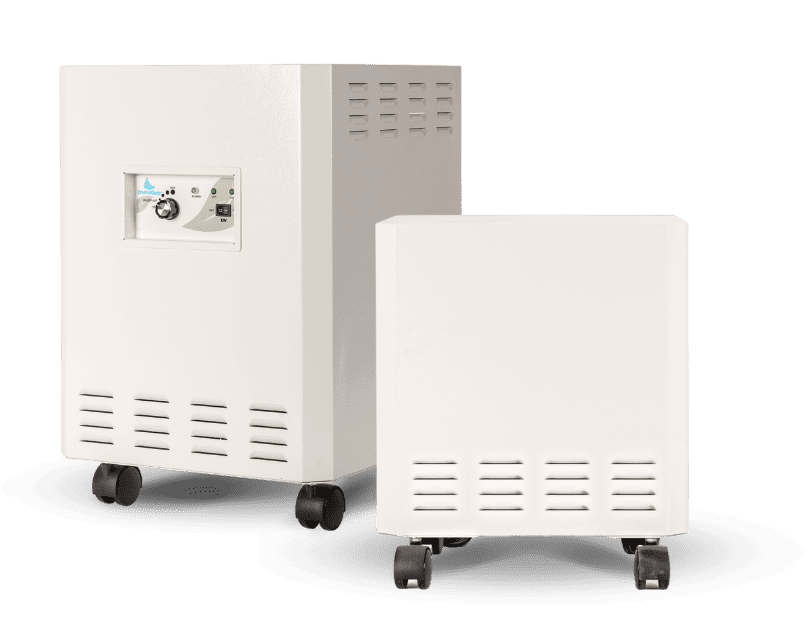Now is the time, the time to get to the bottom of why your house seems to accumulate dust so fast – at a rate that seems impossible! Dust is one of those pesky allergens that are known for developing and accumulating inside of a home, and this can be caused by a multitude of sources within this indoor space. From the occupants or pets living in this area, to the products that are used, and even the lack of cleaning that takes place within this residence, all of which will most definitely aid in the speedy formation of dust throughout the environment on both the surfaces and in the air of the home. Cleaning your home is a good place to start when it comes to correcting the excessive dust formation in your home, however, the process of cleaning your indoor air may be a more challenging cleaning endeavor than simply cleaning the surfaces within this space.
The dust particles that form inside of a home can easily disperse into the air of this space and begin to circulate within the air and be pushed throughout the environment. When this occurs, it will significantly taint the indoor air quality and can even lead to an exacerbation of health problems within those individuals who are frequently exposed to this indoor space. What can be done to reduce dust accumulation in the home and to ultimately get rid of dust that is in your home’s air?
In this article we are going to learn more about why dust accumulates so fast, the causes of dust inside of a home, and the best ways to remove dust from the air – will an air purifier work to remove this allergen?
What is Dust
You know what dust is, but do you really know what it is – the hidden composition that is the driving force behind this pesky, rapidly growing allergen in your home? It has been said that dust is mainly composed of dead skin that is released into the environment from the occupants of the home, however, is this really true. Although human skin is a component that is often found in household dust, it is not the main component of dust as we have often thought it was in the past. According to Wikipedia, dust is made up on fine particles of solid matter such as from plant pollen, human, and animal hairs, textile fibers, paper fibers, minerals from the outdoor soil, human skin cells, and a range of other materials that can be found in the indoor environment of a home.
As household dust is formed and collected within the indoor space of a residence it will easily become airborne within this air space and will potentially pose health risks to children, older people, and those who suffer from respiratory illnesses like asthma and/or allergies. Dust can easily settle into almost any area of the home, going in between nooks and crannies, embedding into carpeting and other upholstered items, and the easiest area to spot dust is on the different surfaces in your home like counters, shelves, tv’s and electronics, etc.
How Does Dust Accumulate
Does it sometimes feel like dust pulls a magic trick in your home, doubling and tripling in the indoor space in what seems like seconds? Dust will work quickly and aggressively within a home to develop, form, and spread throughout the space of this enclosed area. This magic trick of rapid dust accumulation in your home is anything but magic, with most of the time the causes of dust accumulation coming from actual sources and factors that are within this indoor space. Many homeowners will be completely oblivious to the causes of dust production in their home, and this lack of knowledge will only lead to further production of dust in this space in the future. Thus, we are going to discuss below the different sources of dust formation in a home to help homeowners try to minimize potential dust creation in their personal indoor environments in the future.
In addition to household sources that can contribute to dust accumulation, there are also other factors that can lead to excessive dust formation in these indoor environments. Air flow and ventilation are two environmental factors that will help to mitigate dust production in a home, and when air flow and ventilation are both restricted in the indoor space it can allow for dust formation to double and sometimes triple in the home. Ventilation restrictions in a home will leave the space tightly confined which will restrict air flow and therefore easily allow for dust to build up in the home.
Components of Household Dust
Typically, when we think of household dust, we think about all the indoor sources that will create this dust formation in your home. However, just because the dust is in your home doesn’t mean that outdoor dust sources aren’t also mixed in with your indoor household dust. The occupants of a home are the actual culprits behind the entrance of outdoor dust components getting into the indoor space of their home, outdoor sources get brought in through soil particles on shoes, clothing, and even on handbags or other clothing articles and garments. Outdoor components of dust will include soil, minerals, pollen, etc. Whereas indoor components of dust will include carpet fibers, furniture, bedding, pet and animal hair, dead skin, etc.
You may be wondering, where does dust come from and according to NPR, two-thirds of dust come from outdoor sources, in particular soil tracked in and outdoor air particles. Indoor inorganic sources of dust like carpet fibers will make up about one-third of all dust. Therefore, it is important to understand that you need to mitigate both the indoor sources of dust in your home and the outdoor sources to minimize the levels of dust that accumulates inside of your indoor environment.
Why Does Dust Form So Fast
Dust formation in a home is normal, but rapid and aggressive dust buildup within this space is not. If you have begun to notice that every time you dust your home you see not but days later another thick layer of dust on your home’s surfaces and even floating in the air of your home, than it is time to get down to the root cause of why dust is forming so fast in your home. There are three potential major causes that can lead to rapid dust development; vacuuming carpeting in a home, cheap air filters in air handling systems throughout this indoor space, and even leaking air ducts will all contribute to dust buildup in this indoor environment.
Did you know that carpeting inside of a home is one of the major culprits and harbors of dust and dust mites in this space? When you vacuum this flooring, it can kick up the dust into the air and lead to an increase in exposure to occupants in this indoor environment. Additionally, the air filter that you have in place within your home’s air handling system will also aid in the fast production of dust in the environment. Some homeowners will utilize cheap air filters that do a mediocre job of filtering the air of pollutants such as dust and dust mites. These inefficient air filters will ultimately lead to an overabundance of dust in the air which can taint the indoor air quality of a home. Lastly, air ducts that are found in a home can trap and collect pollutants like dust, and when these air ducts leak, they will infiltrate the environment with an excessive level of dust.
What Causes Excessive Dust in My House
The causes and sources of dust production inside of a home are usually all the same in most houses – and they can include upholstery fibers, paper fibers, outdoor pollution, skin cells and hair, pet dander, and air conditioning in these indoor environments. When you combine all of these different causes of dust creation inside of a home it will make it possible for this allergen to quickly and effectively form and spread within this indoor space. Below we are going to learn more about these different sources of dust in a home and how they affect this indoor environment.
- Upholstery Fibers: The furniture and materials inside of your home will be composed of fibers that will eventually be broken down and shed off into the environment of the home. These microscopic fibers when they break off will easily float in the air and settle onto surfaces in the home which will all be taken to compose dust.
- Paper Fibers: Paper is similar to fabric material as they are both made up of fibers. Books and paper products that are found in and throughout a home could be contributing factors to the dust problem in this space.
- Outside Pollutants: Every time you go outside you will end up carrying these tiny pollutants like dirt, grass, pollen, plant spores, and exhaust smoke into the home through clothes, skin, shoes, etc. When these pollutants enter into the home it will also contribute to the dust production in the home.
- Skin Cells & Hair: A major source of dust buildup inside of a home, skin cells and hair will be shed by occupants of this home, including pets and ultimately will be contributed to the excessive dust production in a home.
- Air Conditioning: Some people may find this surprising, but your air conditioning units can trap dust and debris and pollute the indoor air of a home with this allergen.
Dust Inhalation Effects
The formation of dust inside of a home can lead to the exacerbation of several health effects for those occupants that are heavily exposed to this environment. The human lungs are constantly exposed to dangerous pollutants in the air that can lead to a potential exacerbation of health problems like breathing difficulty, asthma and allergy flare ups, and other respiratory issues. When the human lungs become exposed to dust particles in the air, they will enact their defense mechanisms to shield the human body from the potential damage it can emplace on the health of an individual. A person’s nose will act as a filter for particles, when we breathe in the suspended particles in the air will enter the nose, but not all of them will reach the lungs – making the nose an efficient filter.
According to the Canadian Centre for Occupational Health & Safety (CCOHS), the human respiratory system will respond to inhaled particles of dust through a variety of symptoms such as rhinitis, inflammation of the mucous membranes, and inflammation of the trachea and bronchi even.
Best Way to Remove Dust from Air
Dusting the inside of your home may not be as easy as you think it is – especially when it comes to dusting the air space of your home. Cleaning the surfaces in your indoor environment is an effective way to reduce the dust levels inside of your home, however, often times when we dust surfaces a lot of the dust will than become airborne in the air of your home which will leave you back to square one. So, how can you clean and remove dust from the air of your home and is there one method that works better than other solutions?
The traditional methods that have been deployed within homes to help control and reduce dusts is by dusting properly, cleaning bed sheets and linens, vacuuming regularly, mopping floors, and maintaining a clean, tidy home. Although these methods work to clean dust from the surfaces it does little to clean the indoor air. Thus, the reason behind why people are now turning to air cleaners to properly work to remove pollutants like dust from the indoor air.
Do Air Purifiers Get Rid of Dust?
Air purifiers are air cleaning devices that work to properly filter the indoor air of pollutants like dust particles that can be present in the air that is circulating in your home. These air cleaners will all work differently and utilize specific filtration methods to accomplish this air cleaning in the environment – some use carbon, ionization, ozone, and other proprietary technologies to give it its filtration capabilities. Dust is a small allergen that is not only easily found floating in the air, but it is also a pollutant that can be hard to capture due to its smaller size. Thus, it is crucial to find an air purifier that can efficiently filter out these pollutants from the indoor air of your home.
The EnviroKlenz Air Purifier is a revolutionary air purifier that utilizes its own patented technology of safe, nontoxic earth minerals that will work to filter the indoor air of a variety of noxious and toxic chemicals and odors. The EnviroKlenz technology will effectively capture, contain, and completely neutralize these toxic and noxious pollutants from the air, without any concern or fears of them being re-released back into the environment. In addition, this air purifier also contains a hospital-grade HEPA filter for fine particulate matter removal larger than 0.3 microns in size at a 99.99 percent efficiency. This hospital-grade HEPA filter will give this air cleaner its ability to remove small allergens like dust from the air, helping you to clean and get rid of dust in your home quickly and efficiently.
Article Sources:









